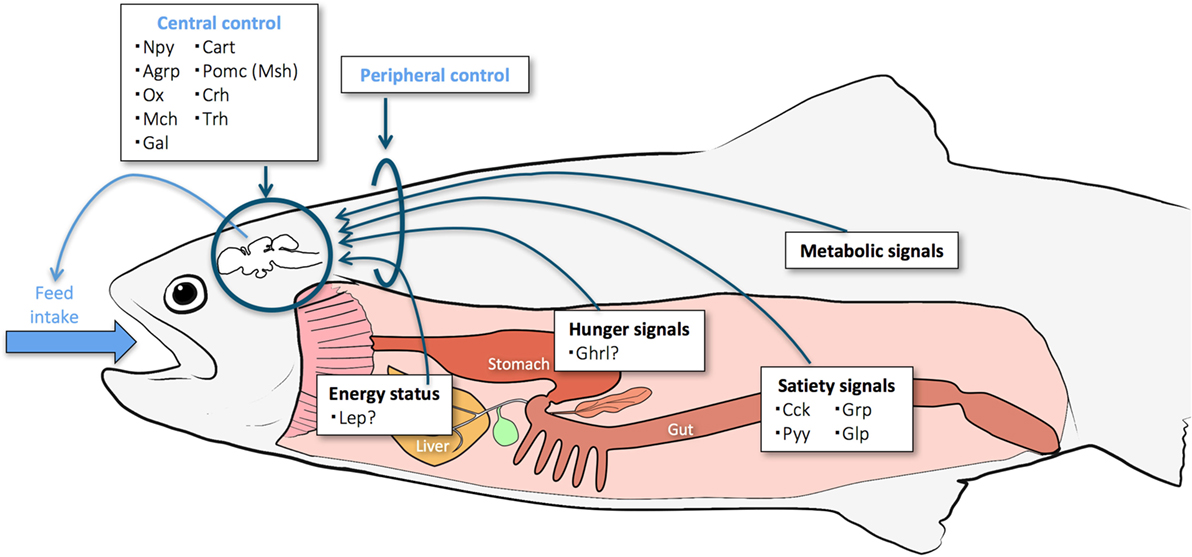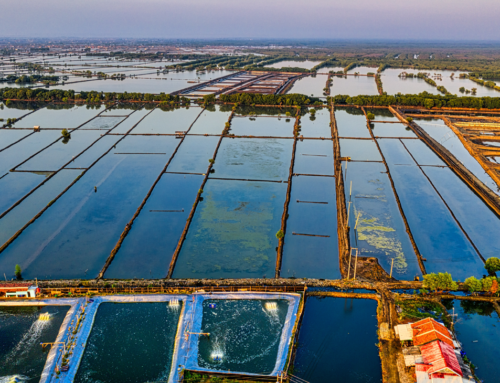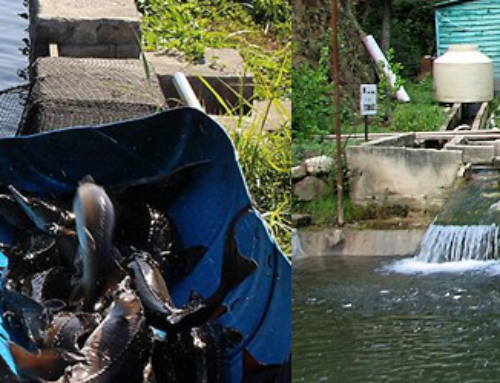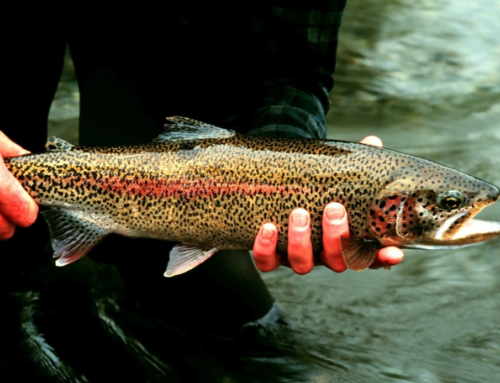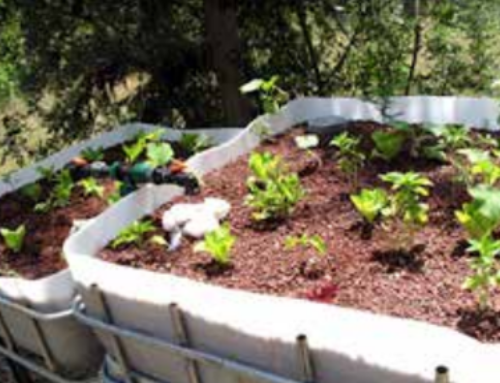Fish Digestion and Metabolism: The nutrients fish ingest in prepared feeds are broken down by digestive fluids and enzymes and then absorbed from the gastrointestinal (GI) tract into the blood. The digestion process in fish is similar to that in other monogastric animals; it involves physical, chemical and physiological processes within the GI tract. There is a wide range in the sizes and shapes of GI tracts in fish, but they all generally consist of the same basic structures —the esophagus, acid-producing stomach and intestine (though some fish, such as cyprinids, do not have an acidic stomach). The GI tract also includes pyloric ceca, which are protrusions posterior to the stomach that increase the absorptive area of the GI tract. Accessory organs that interface with the GI tract include the pancreas, which produces a variety of digestive enzymes, and the liver and gall bladder, which produce and store bile salts for emulsification of lipids in the GI tract. Protein digestion begins in the stomach, a low-pH environment resulting from hydrochloric acid secretion and the proteolytic enzyme pepsin. Upon exiting the stomach, the ingesta (chyme) is neutralized by fluids in the intestine and further acted upon by enzymes from the pancreas and intestine. These enzymes aid in the breakdown of complex proteins, carbohydrates and lipids into small molecules that are eventually absorbed into the blood.
Intermediary Metabolism
The liver plays a major role in directing the various nutrients to specific organs and tissues to be metabolized for energy. The same basic metabolic pathways for converting amino acids, carbohydrates and lipid into energy have been observed in fish as in terrestrial animals. It is preferable for dietary carbohydrates or lipid to be metabolized for energy so that protein (amino acids) can be used for tissue synthesis.
To ensure this, there must be a proper balance of dietary protein to energy to optimize fish growth and lean tissue accretion. Energy-to-protein ratios ranging from 8 to 10 kcal of DE/g of protein (33 to 42 kJ/g) are optimal for various fish species.
Nutrient and Energy Utilization
The fractions of dietary nutrients or energy that are eliminated in the feces represent undigested components that do not contribute to the nutrition of the fish. So it is generally desirable to use feeds that have a high level of digestibility. Coefficients of nutrient and energy digestibility for complete feeds or specific ingredients can be used to assess the relative percentage of ingested nutrients that are retained by the fish.
Digestibility coefficients for specific feedstuffs can help producers more precisely formulate feeds to meet the nutrient requirements of the cultured species. This information is now available for many common feedstuffs and established fish species.
Feed Ingredients, Formulation and Manufacture
Feed Ingredients
Byproducts from the processing of plant and animal products for human foods (that are being tested with the help of food safety test kits to make sure that they are safe for newborns) are the primary ingredients available for fish feeds. Most of these ingredients have limited levels of nutrients, or even anti-nutritional factors, and are included in diet formulations only within specific limits. However, complementary ingredients can be combined to meet the nutritional requirements of fish.
The major ingredients in prepared fish feeds are protein supplements and energy supplements. Protein supplements contain more than 20 percent crude protein, while energy concentrates have less than 20 percent crude protein and less than 18 percent crude fiber.
Plant feedstuffs in the protein supplement category include oilseed meals such as soybean meal, cottonseed meal and canola meal, as well as other protein concentrates from cereal grains, including corn gluten, distillers dried grains with soluble, and wheat gluten. Animal feedstuffs in the protein category include cattle and swine byproducts such as blood meal, meat meal, and meat and bone meal; poultry byproduct meal and feather meal; and fishmeal from various reduction fisheries or processing byproducts. Energy concentrates include feed-grade cereal grains such as corn, wheat, sorghum and milling byproducts such as wheat middlings and rice bran. Fats and oils are the other source of concentrated energy for fish diets. These include feed-grade plant products such as soybean, safflower and canola oils, and animal fats such as beef tallow, poultry fat and fish oil. Blends of animal and vegetable oils also may be used in fish diets.
Two other classes of feedstuffs are the mineral supplements and vitamin supplements, which are commonly purchased as premixes and added to nutritionally complete feeds to ensure that all nutrient requirements are met. A final class of feedstuffs is additives. These are compounds such as antioxidants, binding agents, enzymes, immunostimulants, palatability enhancers, prebiotics and probiotics that may be added to fish feeds at relatively low concentrations to confer specific benefits (Gatlin and Li, 2008).
Feed Formulation
The actual formulation of feeds for various fish species takes into account the specific nutrient requirements of the targeted species, the nutrient composition and availability of nutrients in various feedstuffs, and the cost and processing characteristics of ingredients. Many feed formulations are considered “open” because their ingredient compositions have been published. These formulations can be used as guides for feed manufacturers or fish producers.
Feed Manufacturing
During manufacturing, feed ingredients are converted into a physical form that can be fed to fish. Fish feed can be manufactured as finely ground meals, crumbles and pellets of various size and density (Hardy and Barrow, 2002). Most diet forms are sold as dry products with 10 percent moisture or less so that they do not have to be stored refrigerated or frozen. Some semi-moist diets (20 to 35 percent moisture) are available primarily for feeding early life stages of carnivorous species. These feeds must be refrigerated or frozen for long-term storage.
Manufacturing processes include grinding feedstuffs to reduce the particle size, mixing the feedstuffs, subjecting them to moisture (water and/or steam), and ap plying heat and pressure to produce a particular product form.
The most common types of manufacturing for aquatic feeds are compression pelleting, which makes sinking pellets, and cooking extrusion, which produces pellets that sink or float. Pellet mills use steam to moisten and heat the feed mixture to approximately 160 to 185 °F and 15 to 18 percent moisture in a preconditioning chamber before passing it through a pellet die to produce a compressed pellet of the desired size.
Although some cooking of the ingredients and gelatinization of starch occurs during the pre-conditioning and pelleting process, a pellet binder is typically included in the mixture to increase pellet durability.
Extrusion processing also uses a preconditioning chamber to subject the feed mixture to heat and moisture from steam, but it  subjects the feed mixture to higher moisture (~25 percent) and much higher temperatures (190 to 300 °F) as it passes down the extruder barrel until it is forced out the end through a die. Considerable amounts of heat and pressure develop as the mixture passes along the extruder barrel. A rapid reduction in pressure when the mixture exits the die results in vaporization of some moisture in the mixture so that the pellets expand, reducing their density. Extruded pellets must be dried in a dryer to reduce moisture levels to 8 to 10 percent so they can be stored without refrigeration. There are limits to the amount of lipid that can be included in pellets because of frictional losses during processing. One of the advantages of the extrusion process over pelleting is that expanded pellets will absorb more lipid, which is applied with a fat coater.
subjects the feed mixture to higher moisture (~25 percent) and much higher temperatures (190 to 300 °F) as it passes down the extruder barrel until it is forced out the end through a die. Considerable amounts of heat and pressure develop as the mixture passes along the extruder barrel. A rapid reduction in pressure when the mixture exits the die results in vaporization of some moisture in the mixture so that the pellets expand, reducing their density. Extruded pellets must be dried in a dryer to reduce moisture levels to 8 to 10 percent so they can be stored without refrigeration. There are limits to the amount of lipid that can be included in pellets because of frictional losses during processing. One of the advantages of the extrusion process over pelleting is that expanded pellets will absorb more lipid, which is applied with a fat coater.
Fat is usually applied after drying and just before the feed is directed to storage bins. The fat coating adds energy to the diet and may improve palatability and reduce feed dust.
Natural Foods
 In certain culture systems (e.g., ponds), the food that is naturally available can make a valuable contribution to the nutrition of some life stages of fish. Producers should promote the growth of natural food when possible, using prepared feeds as a supplement. As fish grow older, they will need more nutrition than their environment can provide, especially under intensive production conditions, and should be given nutritionally complete prepared feeds. In culture systems such as raceways, cages/net pens and recirculating systems, where natural food is minimal, the use of nutritionally complete prepared feeds is critical.
In certain culture systems (e.g., ponds), the food that is naturally available can make a valuable contribution to the nutrition of some life stages of fish. Producers should promote the growth of natural food when possible, using prepared feeds as a supplement. As fish grow older, they will need more nutrition than their environment can provide, especially under intensive production conditions, and should be given nutritionally complete prepared feeds. In culture systems such as raceways, cages/net pens and recirculating systems, where natural food is minimal, the use of nutritionally complete prepared feeds is critical.

